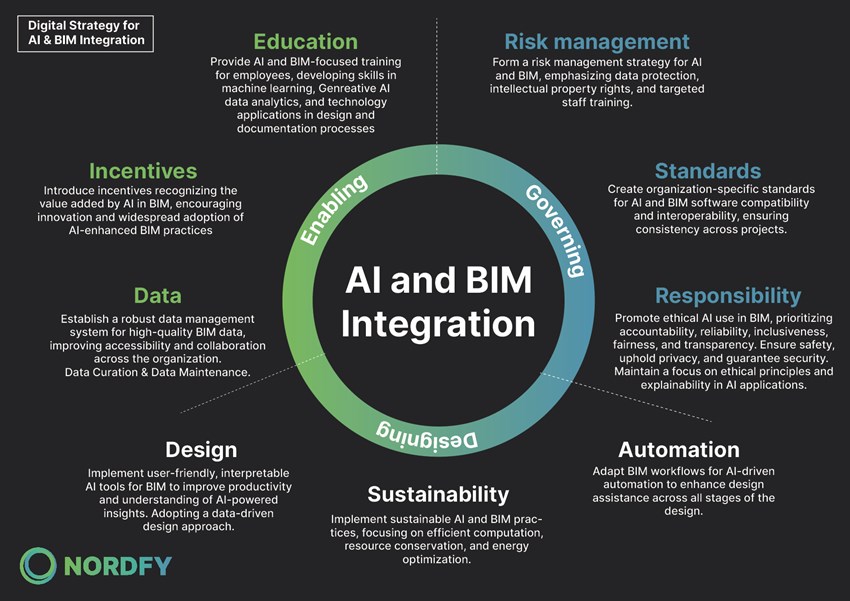 Riccardo Piazzai, Architect, BIM Strategist, and Co-Founder of NORDFY.
Riccardo Piazzai, Architect, BIM Strategist, and Co-Founder of NORDFY.
Revolutionizing the AEC Industry: The AI-BIM Integration
The increased interest in integrating Artificial Intelligence (AI) with Building Information Modeling (BIM) Promises a new landscape full of opportunities and unprecedented efficiencies for architects, engineers, manufacturers, and other industry stakeholders. This integration is shaping a future where sustainability, efficiency, cost, and time management are being redefined, making it a great time for everyone to take advantage of this new wave of innovation.
At the heart of this transformation is the concept of 'prediction', already an essential aspect of digital twins and machine learning, now extending into the design and detailed development stages. The AI-BIM integration not only enhances the final product but also significantly refines the entire process of its creation.
In today's world, building projects generate an enormous volume of digital information, while the advancement of artificial intelligence (AI) requires substantial amounts of digital data to work correctly. This makes the AI-BIM integration an evident and strategic implementation. Current largely automated processes employed by designers and builders, such as BIM, will transition into the autonomous opportunities presented by AI-based processes.
AI can analyze BIM data sets, learn from them, and provide predictive insights contributing to the built environment’s design, construction, and maintenance phases. Manufacturers must understand these processes, as the information and parameters used in their BIM objects could be used to train the AI model. The challenges with AI arise when the available data exists in diverse formats and lacks the uniformity required. In this sense, “data curation” and “data Maintenance” becomes crucial.
If manufacturers adopt a strategy to categorize digital building information according to current AI practices—like data cleaning, indexing, and ensuring consistency—they can make their data accessible for machine intelligence systems.
The Potential of Generative AI in BIM
Generative AI, employs algorithms to create multiple design alternatives based on predefined parameters and project constraints. In the context of BIM, these constraints can include space usage, energy efficiency, material considerations, light exposure, and much more. The AI can utilize specific Revit families that compose the BIM model, along with all the project information, to generate optimal design solutions that meet all these criteria.
Each Revit family, which contains a data collection with a standard set of properties, can be considered a parameter in the generative design process. Generative AI can choose the most appropriate Revit family for a given design based on the data set and overall intent.
For instance, given a data set and overall design intent, a generative AI system could "choose" the most appropriate Revit family (for example, a certain type of window or HVAC system) for a given design. This is typically done by evaluating each potential design against a set of performance criteria and selecting the one that best meets the project's needs. Even if this kind of application for AI in BIM is still in a relatively early stage of development, the technology is rapidly advancing and its capabilities will soon reach this scenario.
How Manufacturers Can Benefit from AI-BIM Integration
For manufacturers, AI-BIM integration offers significant advantages. It enables digitization of their catalogues for BIM processes, with AI providing predictive analysis on products used in BIM models. Creating AI-compatible BIM objects (objects with clean information that the AI model can use) is a crucial step in the rapidly evolving AEC industry. Additionally, simulation modeling is crucial as it involves the creation and analysis of a digital prototype of a physical system to predict its performance.
 AI+BIM Integration wheel
AI+BIM Integration wheel
Such objects enable improved forecasting, conflict detection, and performance tracking. With the swift adoption of AI, the demand for AI-ready BIM objects is projected to surge. Manufacturers prepared to meet this demand by investing in developing these AI-compatible BIM objects will secure a competitive edge in the marketplace.
Additionally, manufacturers can integrate their product data into BIM software, enhancing their capacity to offer tailored solutions based on materials, cost implications, environmental impact, and more. This knowledge can streamline production processes, reducing operational costs.
With the implementation of AI in their BIM processes, manufacturers will witness a considerable change in their workflow. The adoption of AI will not only allow for more accurate market predictions, optimized production, and cost reduction and provide insights into how their products are used in various BIM projects. This will offer crucial input on market trends and potential product enhancements.
However, to truly leverage these benefits, manufacturers need a clear digital strategy for AI adoption, ensuring they remain proactive and future-ready during this technological revolution. The first step is understanding that AI-BIM integration is a remarkable leap in human-machine collaboration. AI's ability to process vast amounts of data complements human intuition and decision-making, resulting in far superior results.
Embracing AI: The Importance of a Digital Strategy
With AI's increasing influence, businesses must revisit their strategies and methodologies. Those equipped with an advanced BIM process and AI integration will lead the market in the forthcoming years. Implementing a well-thought-out digital strategy that outlines the adoption roadmap, identifies areas of risk and opportunity, and sets benchmarks for success will ensure a structured and efficient integration of AI into existing BIM processes.
‘’At NORDFY, we've been privileged to assist companies on the exciting yet complex journey of integrating AI into BIM methodologies. Our experience highlights the widespread benefits of this integration, which applies to organizations of any size or budget.’’ - Ricardo Piazzai Architect, BIM Strategist and Co-Founder of NORDFY

Upskilling, Reskilling, and the Future Workforce
The transformation of the AEC industry extends beyond technology. As AI becomes more prevalent, the need for upskilling and reskilling of the workforce to adapt to these technological advancements is crucial. New roles are emerging, and the workforce is evolving, indicating a shift towards a future where humans and ai work collectively or alongside each other.
Facing these rapid advancements in AI and its integration with BIM, organizations must adapt and seize these opportunities for growth. The industry is witnessing an AI trend that promises to transform operations and processes. The convergence of AI and BIM brings about an entirely new level of process optimization, leveraging Machine Learning (ML) algorithms and Data Science techniques to analyze the vast amounts of data generated by BIM processes, enabling predictions and enhancing decision-making.
For manufacturers and suppliers, this is not a time to stand by and watch. It's time to take a proactive approach, and develop a solid digital strategy. With the right roadmap and the willingness to embrace change, businesses can navigate this technological revolution and establish themselves as pioneers in this new era of the AEC industry.
Ready for your next dose of inspiration? Dive into Riccardo's previous blog on sustainability and digitalization and learn why manufacturers should contribute.







